Asus vs. Alienware: a battle of OLED gaming monitors
The Asus ROG Swift OLED 27 and Alienware 34 QD-OLED are two of the best gaming monitors you can buy, but who claims the OLED crown?

In the span of only a few months, OLED has flooded the world of gaming monitors, and two models rise above the heights of others: Alienware’s 34 QD-OLED and Asus’ ROG Swift OLED 27.
I’ve used both extensively, and although they’re both among the best gaming monitors you can buy, Alienware’s 34 QD-OLED still wins the day. That doesn’t mean you should discount the ROG Swift OLED 27, also known as the PG27AQDM, though. It has a few unique advantages of its own.
Asus ROG Swift OLED 27 vs. Alienware 34 QD-OLED: by the specs
| Asus ROG PG27AQDM | Alienware 34 QD-OLED | |
| Screen size | 27 inches | 34 inches |
| Aspect ratio | 16:9 | 21:9 |
| Panel type | OLED | QD-OLED |
| Resolution | 2,560 x 1,440 | 3,440 x 1,440 |
| Peak brightness | 1,000 nits (HDR) | 1,000 nits (HDR) |
| HDR | Yes | DisplayHDR True Black 400 |
| Local dimming | 3,686,400 zones | 4,953,600 zones |
| Contrast ratio | 1,500,000:1 | 1,000,000:1 |
| Response time | 0.03ms (GtG) | 0.1ms (GtG) |
| Refresh rate | 250Hz | 165Hz |
| Curve | N/A | 1,800R |
| Speakers | N/A | N/A |
| Inputs | 2x HDMI 2.0, 1x DisplayPort 1.4 | 2x HDMI 2.0, 1x DisplayPort 1.4 |
| List price | $1,000 | $1,000 |
Pricing tie, availability nightmare
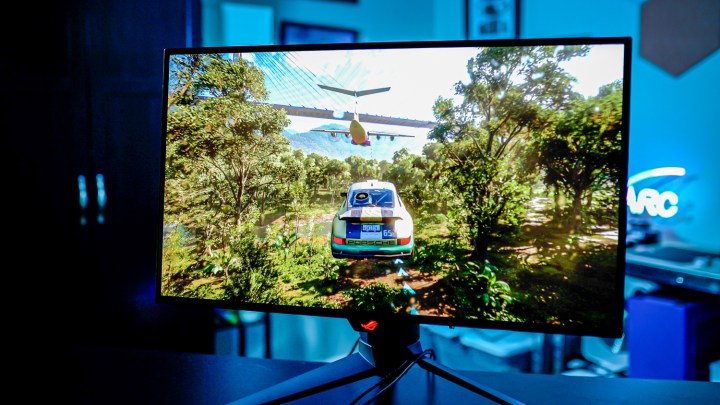 Jacob Roach / Digital Trends
Jacob Roach / Digital TrendsThere would be a large gap in price between the Asus ROG Swift PG27AQDM and Alienware 34 QD-OLED if Alienware hadn’t given its display a mid-gen refresh. You can have either display for the same price: $1,000. There’s a little more to each monitor, though.
The ROG Swift PG27AQDM is sold out everywhere. It will occasionally show up on Amazon for around $1,300, and there are models available on eBay for $1,200 to $1,500, but it will likely be several months before there are plenty of units in stock at the $1,000 list price. I saw something similar happen with the ROG PG42UQ, which is now readily available at list price.
There are alternatives available, namely the LG UltraGear OLED 27 and the Corsair Xeneon OLED 27, both of which use the same OLED panel as the PG27AQDM and are available at $1,000. If you want Asus’ model, which is excellent even outside the panel, you’ll need to wait for it to come back in stock.
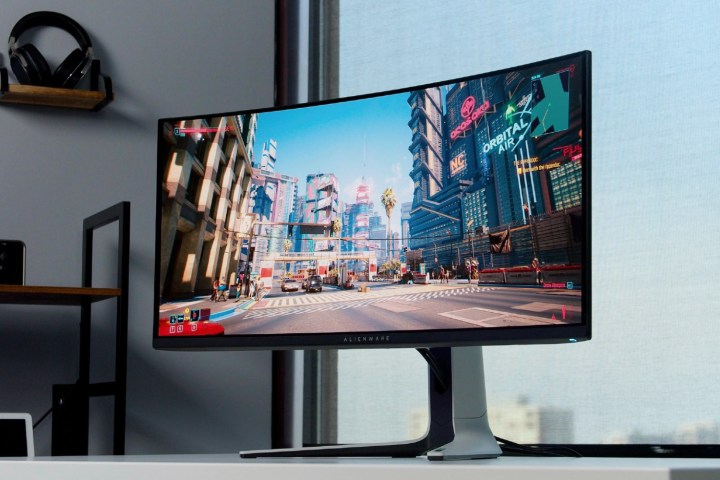
The Alienware 34 QD-OLED doesn’t have stock issues, after being sold out for several months after launch. Not only is it available, it’s cheaper than it was when it released. The display launched at $1,400, but you can pick one up for $1,000 now.
That’s for the AW3423DWF, though, otherwise known as the FreeSync version of the Alienware 34 QD-OLED. There’s also a version available with Nvidia’s G-Sync Ultimate that bumps the refresh rate from 165Hz to 175Hz and the price to $1,200.
For the purposes of this comparison, the FreeSync and G-Sync versions are basically identical. You can spend a little more if you want Nvidia’s validation, but both versions support variable refresh rate across AMD and Nvidia GPUs, and although the FreeSync version has a slower refresh rate, you probably won’t notice a difference.
OLED isn’t equal
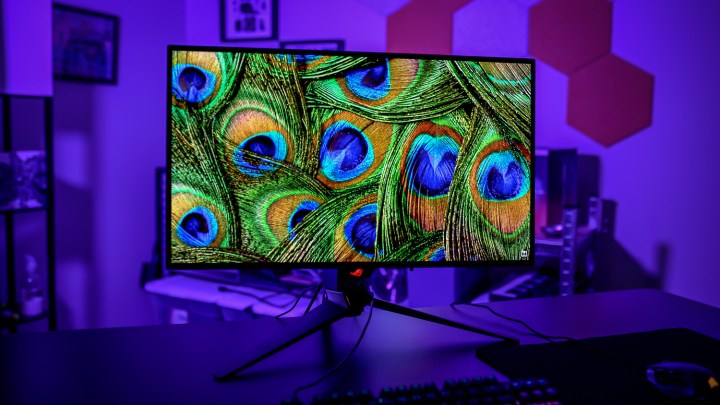 Jacob Roach / Digital Trends
Jacob Roach / Digital TrendsI’m going to get this out of the way upfront: the Alienware 34 QD-OLED and Asus ROG Swift PG27AQDM blow away the vast majority of monitors in image quality. They are both based around OLED panels, allowing independent brightness control of each pixel, and they have fantastic HDR. There are important differences between them, though.
The PG27AQDM is a straight OLED monitor, but it’s also the brightest OLED monitor I’ve tested. It reached nearly 300 nits for the full screen, while most OLED panels barely crack 200 nits. It also reached 931 nits for 3% of the screen, getting close to validating Asus’ brightness claims.
Alienware’s 34 QD-OLED, as the name spoils, is a QD-OLED monitor. Read our explainer on QD-OLED technology for a full breakdown, but the short of it is that QD-OLED combines an OLED panel with quantum dots in an attempt to get a “best of both worlds” display. The idea is to use different colors in the quantum dots combined with a bright backlight to produce higher brightness overall, rather than solely relying on the pixels to produce their own colors.
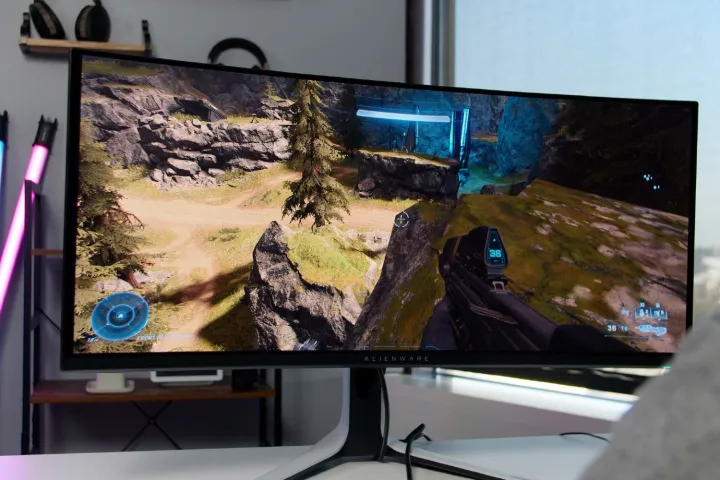
And it works. The Alienware 34 QD-OLED passed 270 nits across the screen based on our testing, surpassing most OLED monitors and matching the exceptionally bright PG27AQDM.
Brightness is on par between the displays, but the Alienware 34 QD-OLED looks much better out of the box. It has better color coverage (95% DCI-P3 and 97% AdobeRGB) than the PG27AQDM (97% PCI-P3 and 91% AdobeRGB) and much better color accuracy.
Asus’ monitor had a color error of over 9 out of the box, while most monitors aim for less than 2. The Alienware 34 QD-OLED, meanwhile, had a color error of 1.86, staying accurate up to 600 nits of brightness. I was able to calibrate the Asus display and get it into a better spot, but there’s no doubt that the Alienware 34 QD-OLED looks nicer out of the box.
Cinematic or competitive gaming
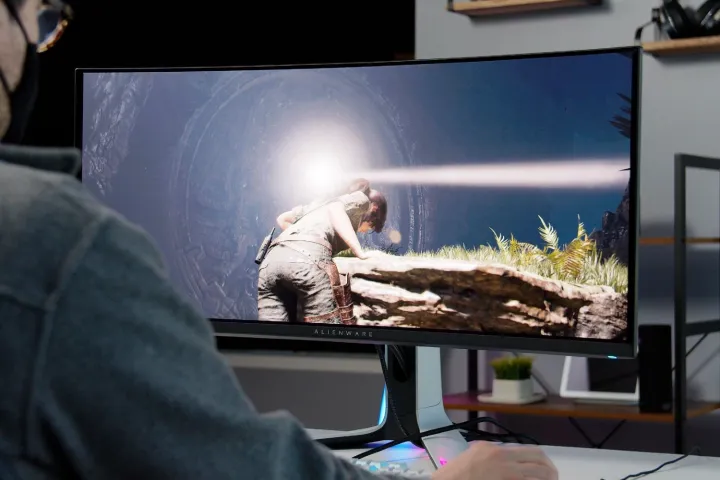
Although both the ROG Swift PG27AQDM and Alienware 34 QD-OLED offer great HDR, there’s more to gaming than just cinematic image quality. The biggest difference between the two monitors is the refresh rate, which could decide the monitor for you depending on the games you play.
The Alienware 34 QD-OLED has a 165Hz refresh rate while the PG27AQDM has a 240Hz refresh rate. I’ve used both extensively, and I can tell you that it takes a highly trained eye to spot the difference between the two. In a random game, you probably wouldn’t be able to pick out one from the other in a blind test.
It’s not a difference in look necessarily, but there is a difference in feel, especially if you are highly attuned to a certain game. For instance, I could easily tell a 240Hz display from a 165Hz one in Overwatch 2, but I wouldn’t be able to tell you the difference in Counter-Strike: Global Offensive. So, if you have a game where you’re highly competitive and know the feel of, the 240Hz refresh rate on the PG27AQDM can make a difference.
 Jacob Roach / Digital Trends
Jacob Roach / Digital TrendsOn the other end, the Alienware 34 QD-OLED is a 21:9, ultrawide monitor. In the games that support a 21:9 aspect ratio, there’s nothing better than the wider field of view immersing you in the game. From Final Fantasy XIV to Destiny 2 to the Horizon Zero Dawn, the extra field of view does wonders to immerse you in a game.
There’s a downside of this aspect ratio, though. Some games, particularly older games and indie releases, will still display in 16:9. There are workarounds for some games through Flawless Widescreen, but there are still a lot of titles it doesn’t cover. On top of that, you have to contend with HUD elements. In some games, such as Destiny 2, HUD overlays are occasionally set at 16:9 despite the fact that the game is at 21:9, showing a hard cutoff on the edge of the screen.
It’s hard making a call between them. For my use, the Alienware 34 QD-OLED is the winner — I play a lot of games, and especially in large AAA releases, the extra screen real estate makes a huge difference. However, if you’re more of someone who has a main competitive game and only dabbles in other releases, the ROG Swift PG27AQDM has a slight edge.
On the desktop
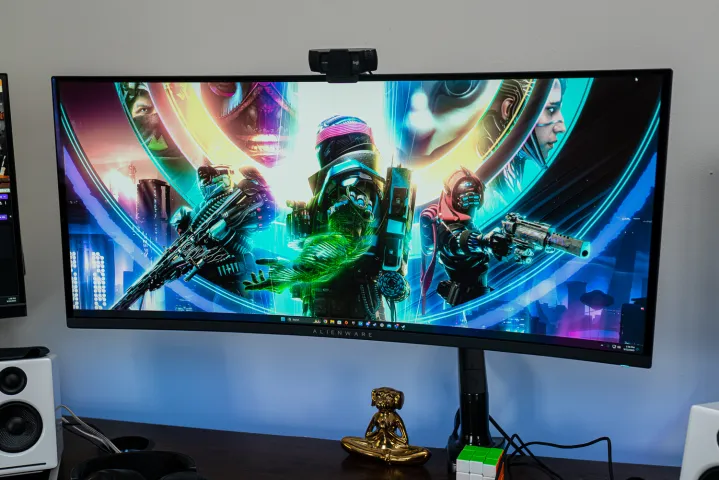 Jacob Roach / Digital Trends
Jacob Roach / Digital TrendsEven with the risk of OLED burn-in being a little overblown, there’s no doubt that using an OLED for productivity carries some risks that aren’t present with traditional LED monitors. That’s true for both the Alienware 34 QD-OLED and ROG Swift PG27AQDM.
But you don’t drop $1,000 on a monitor to avoid the desktop entirely. Thankfully, both displays have burn-in mitigation features that will refresh the panel after a few hours of use. That doesn’t completely eliminate the risk of burn-in, but it helps keep your monitor healthy as long as you keep up with it.
Now, there are some differences for desktop use. Again, this comes down to the aspect ratio. The Alienware 34 QD-OLED is great for pulling up two windows and having them side by side, and it’s definitely the way I prefer to work.
If you’re not concerned with working, though, the ROG Swift PG27AQDM has some advantages. For media consumption, from TV shows to YouTube videos, most content is available in 16:9. Although you can find some movies in the native 21:9 aspect ratio, you’ll mostly see black bars on the Alienware 34 QD-OLED.
In short, the ROG Swift PG27AQDM is the way to go for media consumption, while the Alienware 34 QD-OLED is a little better-suited for work.
Two great monitors

There are some significant differences between the Alienware 34 QD-OLED and ROG Swift PG27AQDM, but the choice between them is less about one being better than the other and more about what you need to use your monitor for.
The Alienware 34 QD-OLED strikes an impossible balance. It’s great for immersive gaming and productivity use in equal strides, and the fact that it’s down to $1,000 makes it seem like a steal. The PG27AQDM doesn’t have that balance, but it shoots ahead in media consumption, from competitive games to movies, even if it falls short in terms of productivity uses.
The balance of the Alienware 34 QD-OLED is best for most people, so if you’re on the fence, that’s the one I’d recommend. The PG27AQDM isn’t a bad choice, though, especially if you fall into one of the areas I’ve highlighted.

 Hollif
Hollif 
































